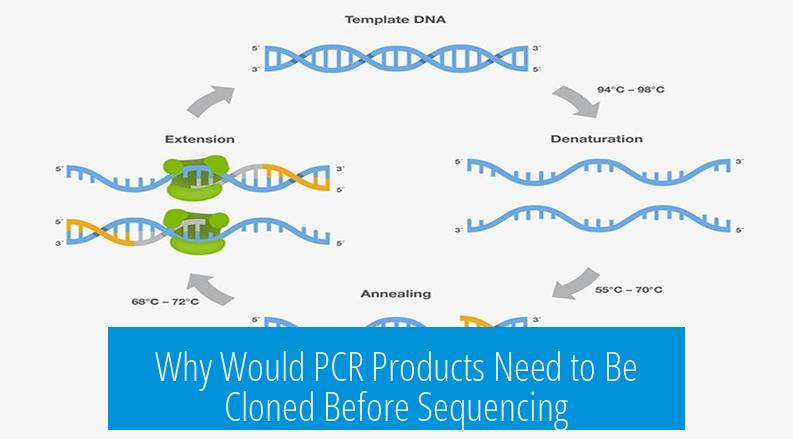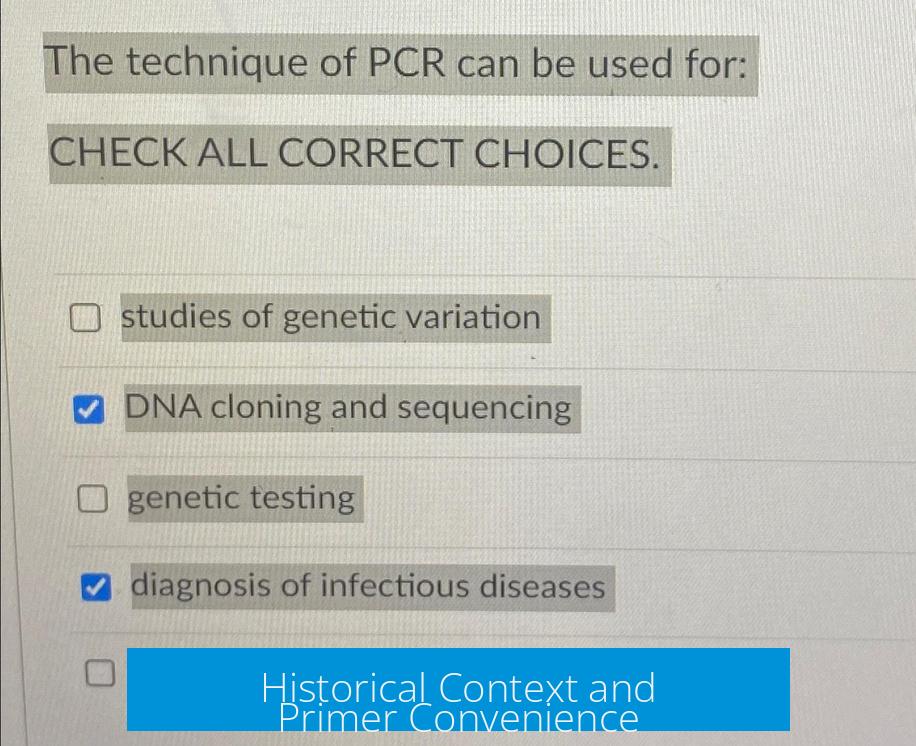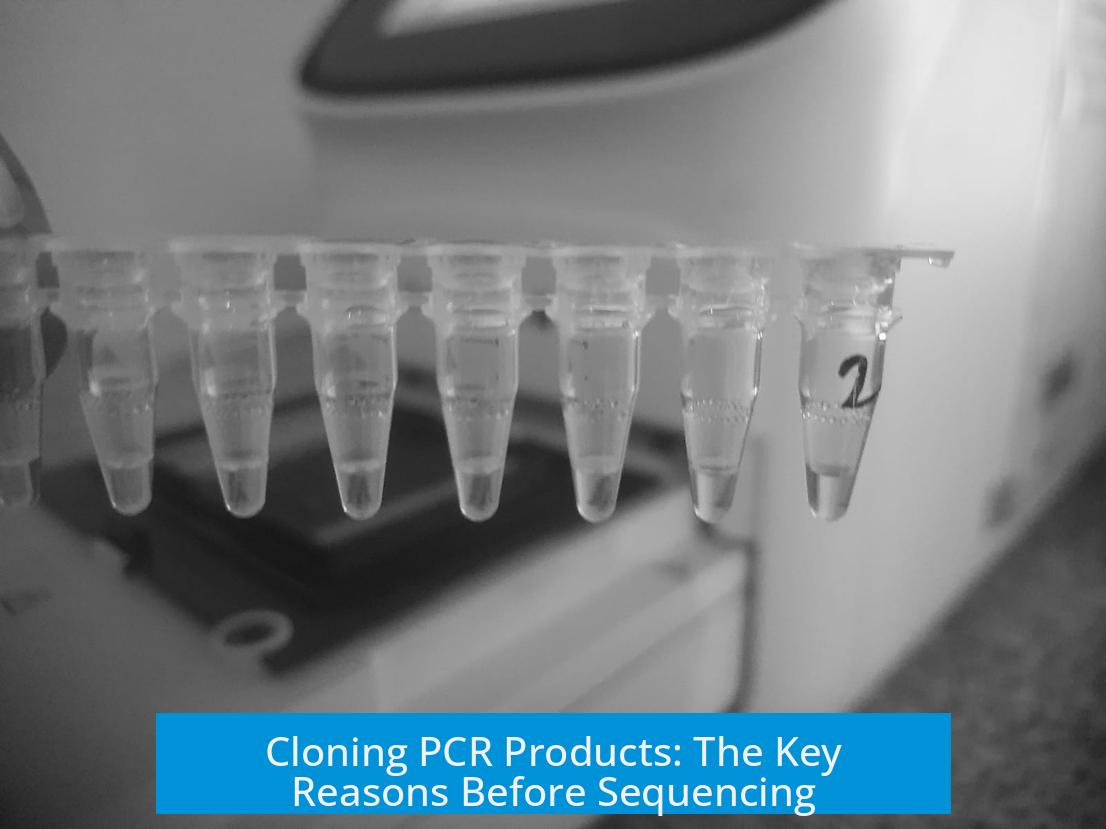Why Would PCR Products Need to Be Cloned Before Sequencing?

PCR products are often cloned before sequencing to ensure accurate, clean, and complete sequence data. This allows the use of universal primers, resolves sequence ambiguities, and provides stable DNA for storage and repeated analysis.
Historical Context and Primer Convenience

Initially, cloning PCR products into bacterial vectors allowed researchers to use universal sequencing primers. This setup was helpful when Sanger sequencing required a consistent and robust primer binding site. With cloning, one primer could initiate sequencing reliably from a known vector site, reducing technical difficulties.
Complete and Reliable Sequencing Reads
Sequencing reactions need a few nucleotides before the region of interest to produce clear reads. Direct sequencing of PCR products often misses the start due to primer annealing issues. Cloning inserts the PCR product into a vector, allowing primers to bind just outside the insert. This framework helps to capture the entire sequence without losing bases near the ends.
Resolving Mixed or Ambiguous Sequences
Many bacteria carry multiple, similar copies of genes such as 16S rRNA. Direct sequencing of PCR products from these genes blends signals from all copies, causing ambiguous base calls at variable positions. Cloning isolates individual gene copies in separate vectors, allowing sequencing of each separately. This method clarifies sequence variants, which is critical when small differences identify distinct species.
Producing Clean and Abundant DNA
PCR is prone to introducing errors during amplification. Cloning followed by propagation in bacteria produces large quantities of uniform DNA from a single, error-free molecule. This purity improves sequencing quality and provides a reliable source for further experiments without repeated PCR amplification.
Long-term Storage and Ease of Re-sequencing
Cloned DNA in plasmids remains stable over time, simplifying storage and repeat sequencing. PCR products degrade faster and may require re-amplification that risks error. Maintaining plasmids in bacterial stocks or glycerol cultures ensures the DNA can be accessed reliably years later, especially when the initial finding is significant and requires validation.
Summary of Key Points
- Cloning enables use of universal sequencing primers for consistent reads.
- Vector-based primers improve sequence coverage at PCR product ends.
- Cloning resolves sequence ambiguities from multiple gene copies.
- It produces ample, high-purity DNA free from PCR errors.
- Plasmids allow reliable long-term storage and easy re-sequencing.
Why Would PCR Products Need to Be Cloned Before Sequencing?
Cloning PCR products before sequencing stems from practical needs like ensuring clean reads, resolving complex sequence mixtures, and simplifying workflow—especially when accuracy and convenience matter. The practice might seem old-school in today’s direct sequencing world, but it still shines in certain demanding scientific quests.
So why exactly do researchers go through the extra step of cloning PCR products before sequencing? Let’s dive into the nuanced reasons behind this practice and shed light on how it helps scientists get better, clearer, and more reliable sequencing results.
1. It Used to Make Sequencing a Breeze
Rewinding a bit, we find that cloning PCR products used to be a go-to method simply for sequencing convenience. Back in the day, sequencing methods like Sanger weren’t as user-friendly as they are now. Sequencing a raw PCR product meant juggling numerous primers, and success was hit-or-miss.
Cloning the product into Escherichia coli vectors allowed scientists to use a universal primer for sequencing. Why is that neat? Well, instead of designing or optimizing a sequencing primer for every new PCR product, one universal primer anchored in the vector worked across many samples. It was like having a master key that opened many doors.
While modern sequencing platforms now allow direct sequencing of PCR amplicons with tailored primers, cloning offered a reliable, hassle-free approach in earlier days. Sometimes, old habits persist because they still get the job done with minimal surprises.
2. Get the Full Picture with Better Primer Placement
Here’s a catch: sequencing reactions don’t see the first few nucleotides of your PCR product clearly. The initial bases often blur out due to technical limits, so direct sequencing can miss parts of the sequence near the primer binding site.
Cloning flips the script. When a PCR product is inserted into a vector, the sequencing primer can bind to the vector sequence a few bases upstream of your insert. This means the sequencing reads cover the entire insert without skipping a single nucleotide at the start.
So if you want a clean, full-length sequence without blind spots, cloning is your friend. It gives you room to position your primer optimally—something direct PCR sequencing struggles with.
3. Resolve Sequence Ambiguity From Multiple Gene Copies
Now, here’s where cloning really flexes its muscles.
Imagine sequencing the 16S ribosomal RNA gene from bacteria. Most bacteria harbor multiple copies of this gene, typically ranging from one to eight copies. These copies are very similar but not identical. When you amplify all copies simultaneously with PCR, direct sequencing produces a mixed signal where variations blur together.
For example, at position X in the sequence, 3 copies might have an “A” and 2 copies a “G.” Direct sequencing can’t tell which variant belongs to which copy. This ambiguity makes it impossible to pinpoint the exact sequence of each gene copy, which is critical when distinguishing species.
Cloning separates each PCR product molecule into its own bacterial colony—effectively isolating individual gene copies. Sequencing these clones gives pure, unambiguous reads of each version.
Such precision helps accurately identify bacterial species, detect minor variants, and disentangle complex microbial genetics. Without cloning, ambiguity could mislead species assignments or molecular conclusions.
4. Obtain Large, Clean DNA Quantities for Reliable Sequencing
PCR is powerful but a bit of a double-edged sword. It can introduce errors like base substitutions or small indels, especially if you amplify many cycles or use non-proofreading polymerases.
Repeatedly amplifying a PCR product to get enough DNA can compound errors and also yield messy mixtures with byproducts. Cloning offers a cleaner route.
Once cloned into a vector, you can culture bacteria to produce large quantities of pure plasmid DNA carrying your exact sequence. This pure plasmid prep supplies high-quality template for sequencing, reducing noise and errors—critical for trustworthy results.
5. For Long-Term Storage and Re-Sequencing Convenience
Here is a bonus that often goes overlooked: easy storage and re-use.
PCR products degrade relatively quickly. Long-term storage risks losing your precious DNA or having to repeat tedious amplifications. Plus, primers might degrade or be hard to reproduce exactly.
Plasmid vectors stash your DNA insert safely inside bacteria or as purified plasmid. This offers a stable, archival form of your sequence. Need to confirm a result months later? Simply pull plasmid DNA out of the fridge and sequence it again without fresh PCR.
This saves time and effort, especially if your PCR product was a rare or minor product hard to amplify again. The cloned plasmid acts like a DNA time capsule, keeping your genetic info pristine.
Summing It Up: Cloning PCR Products Still Holds Value
While direct sequencing of PCR products is now routine and often sufficient, cloning holds critical advantages:
- Universal primer use simplifies sequencing setups.
- Cloning secures full-length, high-quality sequence reads.
- It resolves mixed signals from multiple gene copies or variants.
- Generates ample clean DNA for robust sequencing runs.
- Allows hassle-free long-term storage and re-sequencing.
Think of cloning as a strategic investment—a little extra upfront effort pays dividends in sequence clarity, confidence, and convenience. It shines especially when working with tricky samples, complex mixtures, or when absolute accuracy matters.
So next time you wonder why PCR products sometimes get cloned before sequencing, remember it’s all about giving the sequence a clean stage to perform its best act. Clean, clear, and repeatable sequencing results often start with a well-cloned DNA insert.
Why was cloning PCR products necessary for sequencing in the past?
Cloning was done to use a universal sequencing primer. Early Sanger sequencing needed a single reliable primer. Cloning into a vector helped simplify the process and increase success.
How does cloning help get complete sequencing reads?
Sequencing requires some nucleotides at the start to be reliable. Cloning allows using a primer inside the vector, ensuring the entire PCR product is sequenced completely.
Why clone PCR products when dealing with multiple gene copies?
Some bacteria have several similar gene copies. Direct sequencing can mix signals and cause ambiguity. Cloning separates individual sequences for clear identification of differences.
Does cloning improve DNA quality for sequencing?
Yes, cloning produces cleaner and larger amounts of DNA. PCR can introduce errors, but cloning stabilizes the correct sequence by amplifying plasmids with the target DNA.
Is cloning useful for storing PCR products long-term?
Cloned plasmids allow reliable long-term storage. They can be easily re-sequenced without worrying about PCR failure, making them convenient for future analysis or verification.





Leave a Comment